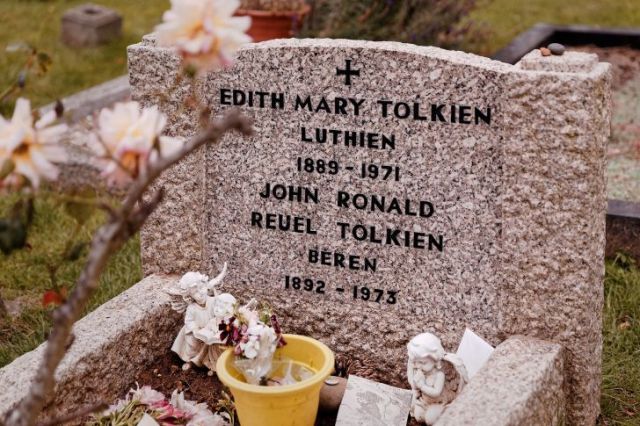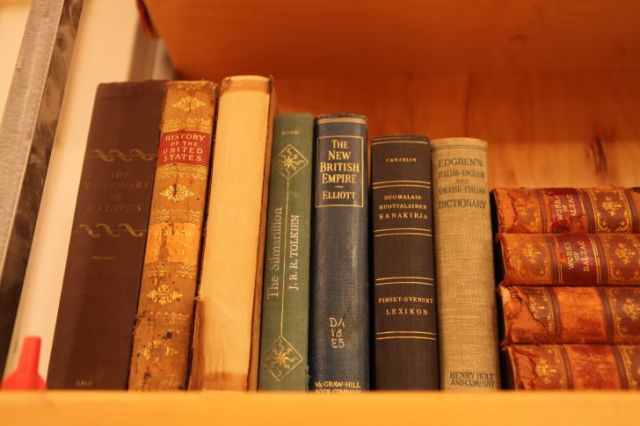
There aren’t many 20th century authors whose popularity could match that of English fantasy icon J.R.R. Tolkien (1892-1973). The mind behind The Lord of the Rings and various other works set in Middle-earth has inspired generations of creators and helped establish the high-fantasy genre as one of the most powerful in the marketplace today. He’s earned armies of admirers and spawned plenty of imitators over the decades, but few, if any, have managed to rival his accomplishments. For more on Tolkien’s compelling life and work, keep reading.
J.R.R. TOLKIEN WAS A SOLDIER IN WORLD WAR I

During his service in World War I, J.R.R. Tolkien came down with “trench fever,” which is a bacterial disease carried by lice that earned its nickname because of how common it was among soldiers fighting in trenches. Pictured above is an example of what life in the trenches looked like.
John Ronald Reuel Tolkien was born in Bloemfontein, South Africa, on January 3, 1892. His family would move to Birmingham, England, in 1896 after his father died, and Tolkien’s mother would pass away just a few years after that. From there, Tolkien ended up living with relatives and in boarding homes under the supervision of a priest. He eventually earned a first-class degree at Exeter College in 1915, studying English Language and Literature. Afterwards, he enlisted for duty in the British Army and was placed in the Lancashire Fusiliers infantry regiment during World War I, where he was involved in the Battle of the Somme in 1916. Tolkien was released after contracting “trench fever,” a bacterial disease carried by lice that causes fever, muscle pain, headaches, and enlargements of the spleen and liver. Before heading into the war, Tolkien married Edith Bratt, whom he had known since he was 16.
J.R.R. TOLKIEN AND C.S. LEWIS MET AT OXFORD UNIVERSITY.
 J.R.R. Tolkien and C.S. Lewis, along with other members of The Inklings, would regularly meet at The Eagle and Child bar in Oxford, England, to talk shop
J.R.R. Tolkien and C.S. Lewis, along with other members of The Inklings, would regularly meet at The Eagle and Child bar in Oxford, England, to talk shop
In 1925, a 33-year-old Tolkien became a professor of Anglo-Saxon at Oxford University, notably lecturing on works like Beowulf. There, Tolkien started a writer’s group, The Inklings, where he later fraternized with C.S. Lewis. The future The Chronicles of Narnia author was also a professor, and the two smoothed out some initial dislike to form a friendship. Both men were fascinated by Norse mythology and used their meet-ups with The Inklings to encourage one another to pursue their fiction work.
J.R.R. TOLKIEN DIDN’T THINK THE HOBBIT WAS A CHILDREN’S BOOK.
 Since its publication in 1937, author J.R.R. Tolkien’s The Hobbit has sold more than 100 million copies.
Since its publication in 1937, author J.R.R. Tolkien’s The Hobbit has sold more than 100 million copies.
While at Oxford, Tolkien began working on the book that would kick off the Middle-earth saga, The Hobbit, which centres on Bilbo Baggins, a diminutive hero who endures a series of adventures along with a troupe of dwarves and the wizard Gandalf. When the book was published in 1937, it was considered by some to be written for children, though Tolkien said that wasn’t his intention. In a nod to his future efforts offering illustrated maps for his Lord of the Rings saga, Tolkien also created over 100 drawings to add dimension to his first novel.
J.R.R. TOLKIEN’S WIFE INSPIRED HIS CHARACTERS.
 The burial site of Edith and J.R.R. Tolkien, with “Luthien” and “Beren” inscribed on the headstone.
The burial site of Edith and J.R.R. Tolkien, with “Luthien” and “Beren” inscribed on the headstone.
Tolkien clearly drew inspiration for his Lord of the Rings series from studying mythology and fantasy fiction. But he also found his muse in his wife, Edith Tolkien. One day, according to a feature on Newsweek, Tolkien watched as Edith danced in a wooded area in Yorkshire. As the war pressed on, Tolkien was soothed by his wife’s grace. Struck by her beauty and elegance, Tolkien began writing a story about an Elvish princess named Lúthien and her love, Beren. The tale was so important to the couple that the characters’ names were engraved on their joint headstone.
The story of Beren and Lúthien eventually found its way into The Silmarillion, a collection of tales that gave more detail to the world of Middle-earth. An expanded version, simply titled Beren and Lúthien, was published as its own standalone book in 2017, more than 40 years after Tolkien’s death.
J.R.R. TOLKIEN WAS A TERRIBLE DRIVER.
In 1932, Tolkien purchased a Morris Crowley automobile. Because cars were still a relatively new phenomenon, Tolkien had not had much of an opportunity to practice controlling the vehicle. By all accounts, he was a terror behind the wheel, driving on flat tires, crashing into stone walls, and speeding through intersections.
J.R.R. TOLKIEN’S SON, CHRISTOPHER TOLKIEN, CARRIED ON HIS FATHER’S LEGACY.
 Author J.R.R. Tolkien began working on stories that comprised The Silmarillion as far back as 1914, but he wouldn’t live to see them published. It was his son, Christopher, who edited and completed the tales, which were then published in 1977.
Author J.R.R. Tolkien began working on stories that comprised The Silmarillion as far back as 1914, but he wouldn’t live to see them published. It was his son, Christopher, who edited and completed the tales, which were then published in 1977.
Born in 1924, Christopher Tolkien was said to have assisted in his father’s work at a very early age. As a child, he would point out mistakes in bedtime stories and was tasked with reviewing The Hobbit for errors. Later, Christopher drew the main Middle-earth map for The Lord of the Rings. When J.R.R. Tolkien died in 1973, Christopher became the executor of his father’s estate, seeing to it that unpublished works like The Silmarillion saw the light of day. Christopher passed away in 2020 at the age of 95.
THE J.R.R. TOLKIEN MOVIE BASED ON HIS LIFE WAS DISAVOWED BY HIS ESTATE.
 Lily Collins and Nicholas Hoult played Edith Bratt and J.R.R. Tolkien, respectively, in the 2019 film Tolkien.
Lily Collins and Nicholas Hoult played Edith Bratt and J.R.R. Tolkien, respectively, in the 2019 film Tolkien.
In 2019, Fox Searchlight released Tolkien, a biopic based on the author’s life, starring Nicholas Hoult, from the X-Men franchise, as J.R.R. Tolkien and Lily Collins as wife Edith. The film examines Tolkien’s wartime experiences and his efforts to create his fictional worlds. But the Tolkien estate was unhappy with the movie, saying in a statement that it didn’t approve or authorize it and had no involvement in the production.
J.R.R. TOLKIEN’S MIDDLE-EARTH READING ORDER.
Tolkien’s enduring legacy is his Middle-earth saga, which places a heavy focus on the efforts of hobbits Frodo, Sam, and others to confront the Dark Lord Sauron and prevent him from obtaining the One Ring that would give him dominion over the world. The saga grew to encompass several titles beyond The Lord of the Rings and can be read in the order in which they were published:
- The Hobbit (1937)
- The Lord of the Rings; The Fellowship of the Ring (1954)
- The Lord of the Rings: The Two Towers (1954)
- The Lord of the Rings: The Return of the King (1955)
- The Adventures of Tom Bombadil and Other Verses from the Red Book(1962)
- The Silmarillion (1977, posthumous)
- Unfinished Tales (1980, posthumous)
- The History of Middle-earth (1983-1996, posthumous)
- The Children of Húrin (2007, posthumous)
- Beren and Lúthien (2017, posthumous)
- The Fall of Gondolin (2018, posthumous)
MOST NOTABLE J.R.R. TOLKIEN QUOTES:
- “If you really want to know what Middle-earth is based on, it’s my wonder and delight in the earth as it is, particularly the natural earth.”
- “Deep roots are not reached by the frost.” (From The Fellowship of the Ring)
- “Courage is found in unlikely places.” (From The Fellowship of the Ring)
- “Not all those who wander are lost.” (From The Fellowship of the Ring)
- “Short cuts make long delays.” (From The Fellowship of the Ring)
- “The war made me poignantly aware of the beauty of the world.”








